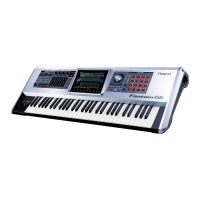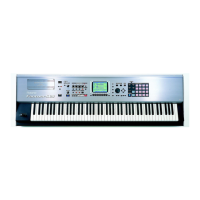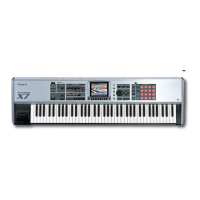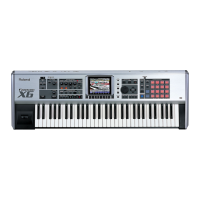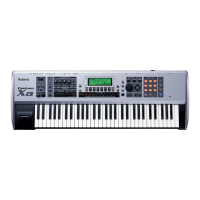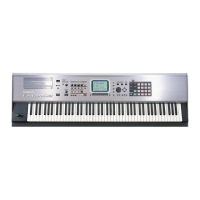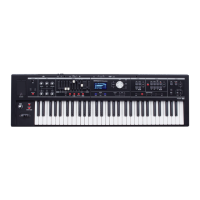251
Editing Songs
Overview Sound 1 Sound 2 Sound 3 Pad Sampler
Menu/System
AppendixSequencer
Editing a System Exclusive Message
1.
Use
or to move the cursor to the location of the
system exclusive message that you want to edit.
2.
Press
.
The System Exclusive Edit window appears.
3.
Press
or to move the cursor to the data that you
want to edit.
4.
Turn the VALUE dial or press [INC] [DEC] to edit the value.
If you want to add data between “F0:” and “:F7,” move the
cursor to that location and press [F3 (Insert)]. A value of “00”
will be inserted. Change this to the desired value.
To delete data, move the cursor to the relevant location and
press [F2 (Delete)].
5.
When you are finished editing, press [F8 (Execute)] to
finalize the values of the system exclusive message.
To cancel, press [F7 (Cancel)].
If you decide to discard the changes you made to the system
exclusive message and return to the Microscope screen, press
[EXIT].
• In the case of a Roland type IV system exclusive message, the
checksum can be calculated automatically when you finalize the
values. If you do not want to calculate the checksum
automatically, press [F1 (Auto Sum)] to turn off the light.
• When you press [F4 (Test)], the system exclusive message you
are editing will be transmitted from the MIDI OUT connector.
Phrases can record the following eight types of sequencer data. The
recorded location (measure-beat-tick) is displayed at the far left of
each data item, and the MIDI channel number is displayed beside it.
Note
These MIDI messages represent notes. From the left, the parameters
are Note Number, which indicates the name of the note; On Velocity,
which specifies the force with which the key is pressed; Duration,
which specifies the duration of the note; and Off Velocity, which
determines the force with which the key is released.
Program Change
This MIDI message switches sounds. The program number (PC#)
selects the sound.
Control Change
This MIDI message applies various effects such as modulation or
expression. The controller number (CC#) selects the function, and
Value specifies the depth of the effect.
Pitch Bend
This MIDI message changes the pitch. The value specifies the
amount of pitch change.
Poly Aftertouch
This MIDI messages applies aftertouch to an individual note. From
the left, the parameters are Note Number which specifies the key,
and Value which specifies the depth of the aftertouch.
Channel Aftertouch
This MIDI message applies aftertouch to an entire MIDI channel.
Value specifies the depth of the aftertouch.
System Exclusive
These are MIDI messages used to make settings unique to the
Fantom-G, such as sound settings. Input the data between “F0” and
“F7.”
Tune Request
This MIDI message causes an analog synthesizer to tune itself.
Sequencer Data Handled by Phrases
Fantom-G_r_e.book 251 ページ 2009年7月2日 木曜日 午後2時55分

